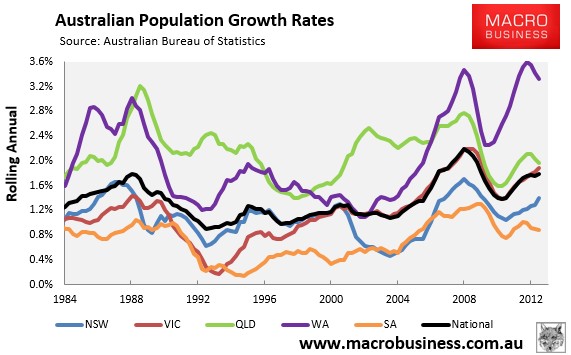
Over the past few years, I have written a bunch of articles questioning the efficacy of Australia’s high population (immigration) growth strategy, which provides dubious economic benefits and creates a number of adverse impacts on living standards and the environment.
Since late-2006, Western Australia has experienced the highest rate of population growth in the country, averaging nearly 3.0% per annum over this period (see next chart).

Now the strain of this high population growth is beginning to bite, with Western Australian Premier, Colin Barnett, proposing to stagger Perth trading hours in a bid to combat Perth’s worsening traffic congestion:
“It would serve customers better, give the businesses more flexibility and may also help with congestion issues” [Colin Barnett said]…
Chamber of Commerce and Industry WA chief executive Deidre Willmott welcomed the Premier’s “encouraging comments”…
“Congestion is a major issue for business as well as its employees … it is continuing to cut into Perth business productivity and profitability and is impacting on their ability to recruit, manage and retain staff.”
Meanwhile, Perth’s swelling population is reportedly placing intense strain on its hospital system, with patients now increasingly being treated in hospital corridors:
Doctors and nurses have complained of worsening “corridor care” in hospitals…
Australian Nursing Federation state secretary Mark Olson said corridor care was becoming normal because the State Government was trying to push patients from emergency departments to hospitals wards that were full.
“It is unsafe and irresponsible to expect patients to be cared for in corridors, alcoves and storage rooms, and this corridor care is just another manoeuvre to get around the minimum nurse-to-patient ratios” he said.
The above highlights some of the problems with rapid population growth. Unless there are corresponding investments in infrastructure and social services, then the pre-existing population finds itself saddled with higher congestion, lower amenity, and overall lower living standards. On the other hand, if investment does take place to cater for the growing population, then the pre-existing population is left paying for the upgrades, which in many cases have a higher marginal cost than for investments made generations earlier (think desalination plants versus dams). In turn, average household bills can be raised, also leaving the average citizen worse-off.
Dog meet tail.

